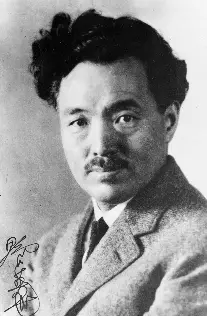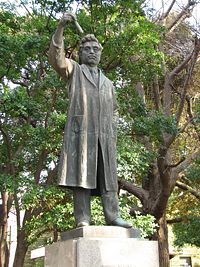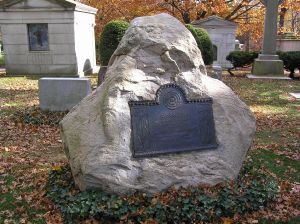Difference between revisions of "Hideyo Noguchi" - New World Encyclopedia
Keisuke Noda (talk | contribs) |
Keisuke Noda (talk | contribs) |
||
| Line 304: | Line 304: | ||
==External links== | ==External links== | ||
All links are retrieved January 5, 2009. | All links are retrieved January 5, 2009. | ||
| − | + | ||
* Japanese Government Internet TV: [http://nettv.gov-online.go.jp/eng/prg/prg1143.html streaming video, "Hideyo Noguchi Africa Prize," 2007/04/26 (5 mins.)] | * Japanese Government Internet TV: [http://nettv.gov-online.go.jp/eng/prg/prg1143.html streaming video, "Hideyo Noguchi Africa Prize," 2007/04/26 (5 mins.)] | ||
* Fukushima Prefecture: [http://www.pref.fukushima.jp/list_e/ym961_le.html "The Dreamer, Hideyo Noguchi," slide show] | * Fukushima Prefecture: [http://www.pref.fukushima.jp/list_e/ym961_le.html "The Dreamer, Hideyo Noguchi," slide show] | ||
| Line 310: | Line 310: | ||
* Japan Society for the Promotion of Science (JSPS): [http://www.jsps.go.jp/english/e-noguchiafrica/index.html Purpose and Description of the Noguchi Prize] | * Japan Society for the Promotion of Science (JSPS): [http://www.jsps.go.jp/english/e-noguchiafrica/index.html Purpose and Description of the Noguchi Prize] | ||
* [[National Diet Library]]: [http://www.ndl.go.jp/portrait/e/datas/312.html?c=26 NDL portrait] | * [[National Diet Library]]: [http://www.ndl.go.jp/portrait/e/datas/312.html?c=26 NDL portrait] | ||
| − | + | ||
{{credits|Hideyo_Noguchi|261467566}} | {{credits|Hideyo_Noguchi|261467566}} | ||
Revision as of 03:43, 5 January 2009
|
Hideyo Noguchi | |
|---|---|
 Hideyo Noguchi wit signature | |
| Born |
November 24 1876 |
| Died | May 21 1928 (aged 51) |
| Nationality | Japan |
| Field | bacteriology |
| Known for | syphilis Treponema pallidum |
- This is a Japanese name; the family name is Noguchi.
Hideyo Noguchi (野口 英世 Noguchi Hideyo, November 24, 1876 – May 21, 1928), also known as Seisaku Noguchi (野口清作 Noguchi Seisaku), was a prominent Japanese bacteriologist who discovered the agent of syphilis in 1911.
Early life
Noguchi Hideyo was born as the eldest son of Sayosuke Noguchi (father) and Shika (mother), in Inawashiro, Fukushima prefecture on November 9, 1876. His youth name is Seisaku (清作). Noguchi family was a poor peasant for generations. When he was one and a half years old he fell down into a fireplace and suffered a burn injury on his left hand. There was no doctor in the small village, but one of the men examined the boy. "The fingers of the left hand are mostly gone," he said, "and the left arm and the left foot and the right hand are burned; I know not how badly." Due to his injury to his left hand, he could not expect to become a peasant.[1]
Shika, Noguchi's mother, had a strong faith in Kwannon Buddhism. It is said that she prayed day and night to ask Buddha to save her son. During her prayer life, she determined to give him an education so that Noguchi can find his way in spite of physical handicap. For Noguchi's family as a poor peasant, it looked impossible to send him to a school. Shika did additional physical labor to raise extra fund.
Sakae Kobayashi (小林栄), a teacher at the Inawashiro elementary school, financially supported the family, which made it possible for Noguchi to enter the elementary school in 1889. He was smart and teachers soon recognized his abilities. Thanks to generous contributions from his teacher Kobayashi and his friends, he was able to receive surgery from Kanae Watanabe on his badly burned left hand. He recovered about 70% mobility and functionality in his left hand through the operation.
Noguchi decided to become a doctor to help those in need. He often cited the words, "Napoleon did not sleep more than three hours" and practiced it to save time for study. When he left his hometown for Tokyo to study medical science, he left the words, "I will never step the soil of my hometown until I accomplish my will."
He apprenticed himself to Dr. Kanae Watanabe (渡部鼎 Watanabe Kanae), the same doctor who had performed the surgery on his hand. He passed the examinations to practice medicine when he was twenty years old in 1896. He showed signs of great talent and was supported in his studies by Dr. Morinosuke Chiwaki.
In 1898, he changed his first name to Hideyo after reading a fictional novel about a man who had the similar name - Nonoguchi Seisaku (野々口精作) - as him. The character in the novel was intelligent like Noguchi, but became lazy and ruined his life. Noguchi found the similar shortcomings in the character of the novel and changed his name from Seisaku to Hideyo (英世) to make a new start of life.
Career
In 1898, Noguchi became an assistant of Shibasaburo Kitazato at his research institute of infectious disease. He met Dr. Simon Flexner at the institute. Due to his excellent work, Noguchi was dispatched to China as a member of international pest prevention committee.
In 1900 Noguchi moved to the United States, where he obtained a job as a research assistant with Dr. Simon Flexner at the University of Pennsylvania and later at the Rockefeller Institute of Medical Research. He thrived in this environment.[2] At this time his work concerned poisonous snakes. In part, his move was motivated by difficulties in obtaining a medical position in Japan, as prospective employers were concerned about the impact the hand deformity would have on potential patients. In a research setting, this handicap became a non-issue. He and his peers learned from their work and from each other. In this period, a fellow research assistant in Flexner's lab was Frenchman Alexis Carrel, who would go on to win a Nobel Prize in 1912;[3] and Noguchi's work would later attract the Prize committee's scrutiny.[4] The Nobel Foundation archives have been only recently opened for public inspection; and what was once only speculation is now confirmed. He was nominated in 1913, 1914, 1915, 1920, 1921, 1924, 1925, 1926, and 1927.
While working at the Rockefeller Institute of Medical Research in 1913, he demonstrated the presence of Treponema pallidum (syphilitic spirochete) in the brain of a progressive paralysis patient, proving that the spirochete was the cause of the disease. Dr. Noguchi's name is remembered in the binomial attached to another spirochete, Leptospira noguchii.[5]
Noguchi worked so tirelessly, fellow researchers whispered, "when do Japanese sleep?"[6]
In 1918, Noguchi traveled extensively in Central America and South America to do research for a vaccine for yellow fever, and to research Oroya fever, poliomyelitis and trachoma. While in Ecuador, he received a commission as a colonel in the Ecuadoran Army.
In 1928, Noguchi traveled to Africa to confirm his findings. The purpose of this field work was to test the hypothesis that yellow fever was caused by spirochaete bacteria instead of a virus. While working in Accra, Gold Coast (modern-day Ghana) he was struck down by the yellow fever virus, his last words being "I don't understand."[7]
Honors during Noguchi's lifetime
Noguchi was honored with both Japanese and foreign decorations. He received honorary degrees from a number of universities.
He was discretely self-effacing in his public life, and he often referred to himself with naive objectiveness, as "funny Noguchi;" but those who knew him well reported that he "gloated in honors."[8] When Noguchi was awarded an honorary doctorate at Yale, William Lyon Phelps observed that the Kings of Spain, Denmark and Sweden had conferred awards, but "perhaps he appreciates even more than royal honors the admiration and the gratitude of the people."[9]
- Kyoto Imperial University - Doctor of Medicine, 1909.[10]
- Order of Dannebrog, 1913 (Denmark).[11]
- Order of Isabella the Catholic, 1913 (Spain).[12]
- Order of the Polar Star, 1914 (Sweden).[13]
- Tokyo Imperial University - Doctor of Science, 1914.[13]
- Order of the Rising Sun, 4th class—1915.
- Imperial Award, Imperial Academy (Japan) - 1915.[14]
- University of Quito, 1919 - (Ecuador).[15]
- University of Guayaquil, 1919 - Ecuador.[15]
- Yale University, 1921 - (US).[9]
Legacy
Posthumous honors
In 1928, the Japanese government awarded Noguchi the Order of the Rising Sun second class.[16]
In 1979, the Noguchi Memorial Institute of Medical Research (NMIMR) was founded with funds donated by the Japanese government.[17] The Institute is located at the University of Ghana in Legon, a suburb north of Accra.[18] After his death, Noguchi's body was returned to the United States; but the mere existence of the NMIMR is arguably a more fitting memorial than the modest marker in New York City's Woodlawn Cemetery.[19]
Dr. Noguchi's portrait has been printed on Japanese 1000 yen banknotes since 2004.[20] In addition, the house where he was born and brought up is preserved and is part of a museum to his life and its achievements.
Hideyo Noguchi Africa Prize
The Japanese Government established the Hideyo Noguchi Africa Prize in July 2006 as a new international medical research and services award to mark the official visit to by Prime Minister Junichiro Koizumi to Africa in May 2006 and the 80th anniversary of Dr. Noguchi’s death.[21] The Prize aims to honor individuals with outstanding achievements in combating various infectious diseases in Africa or in establishing innovative medical service systems.[22] The presentation ceremony and laureate lectures coincided with the Fourth Tokyo International Conference on African Development (TICAD)in late April 2008.[23] This year's conference venue was moved from Tokyo to Yokohama as another way of honoring the man after whom the prize was named. In 1899, Dr. Noguchi worked at the Yokohama Port Quarantine Office as an assistant quarantine doctor.[24]
The first awards of this international prize—consisting of a citation, a medal and an honorarium of 100 million yen (US$843,668) are only intended to be the first in a continuing series; and subsequently the Prize is expected to be awarded every five years.[25] The prize as been made possible through a combination of government funding and private donations.[26]
See also
Notes
- ↑ Noguchi Hideyo (Japanese), IFSA. Retrieved January 5, 2009.
- ↑ Flexner, James Thomas. (1996). Maverick's Progress, pp. 51-52.
- ↑ Gray, Christopher. " Streetscapes/Rockefeller University, 62nd to 68th Streets Along the East River; From a Child's Death Came a Medical Institute's Birth," New York Times. February 25, 2001.
- ↑ Japanese Government Internet TV: "Hideyo Noguchi Africa Prize," streaming video 2007/04/26
- ↑ Dixon, Bernard. "Fame, Failure, and Yellowjack," Microbe Magazine (American Society for Microbiology). May 2004. Retrieved January 5, 2009.
- ↑ 野口英世年表 (Noguchi Hideyo choronology), Aizuwakamatsu city official site. Retrieved January 5, 2009.
- ↑ BBC/H2g2: Yellow Fever blurb.
- ↑ "'Funny Noguchi,' Time. May 18, 1931.
- ↑ 9.0 9.1 "Angll Inaugurated at Yale Graduation; New President Takes Office Before a Distinguished Audience of University Men;784 Degrees are given; Mme. Curie, Sir Robert Jones,Archibald Marshall, J.W. Davis and Others Honored," New York Times. June 23, 1921. Cite error: Invalid
<ref>tag; name "nyt1921" defined multiple times with different content - ↑ Kita, Atsushi. (2005). Dr. Noguchi's Journey: A Life of Medical Search and Discovery, p. 169.
- ↑ Kita, p. 181.
- ↑ Kita, p. 177;
- ↑ 13.0 13.1 Kita, p. 182. Cite error: Invalid
<ref>tag; name "k182" defined multiple times with different content - ↑ Kita, p. 186.
- ↑ 15.0 15.1 Japan, Ministry of Foreign Affairs. Noguchi & Latin America Cite error: Invalid
<ref>tag; name "jmofa2" defined multiple times with different content - ↑ "Mikado Honors Dr. Noguchi, New York Times. June 2, 1928.
- ↑ UNiversity of Pennsylvania: Global Health Project
- ↑ University of Ghana: Noguchi Institute (NMIMR).
- ↑ " A Place for All Eternity In Their Adopted Land," New York Times. September 1, 1997.
- ↑ Bank of Japan: Valid Bank of Japan Notes, as of August 2004; Brook, James. "Japan Issues New Currency to Foil Forgers," New York Times. November 2, 2004
- ↑ Japan Science and Technology Agency: " Comemorative Lecture: The First Hideyo Noguchi Africa Prize," Science Links Japan web site.
- ↑ Rockefeller Foundation: Noguchi Prize, history
- ↑ Japan, Cabinet Office: Noguchi Prize, chronology
- ↑ Hideyo Noguchi Memorial Museum: Noguchi, life events
- ↑ World Health Organization: Noguchi Prize, WHO/AFRO involved
- ↑ "Noguchi Africa Prize short by 70% of fund target," Yomiuri Shimbun (Tokyo). March 30, 2008.
ReferencesISBN links support NWE through referral fees
Selected works by Noguchi
- Washington, D.C.: Carnegie Institution.
- Washington, D.C.: Carnegie Institution.
- Philadelphia: J. B. Lippincott.
- New York: P. B. Hoeber.
Secondary sources
- D'Amelio, Dan. Taller Than Bandai Mountain: The Story of Hideyo Noguchi. New York: Viking Press. 10-ISBN 9-997-50238-8; 13-ISBN 978-9-997-50238-4 (cloth) [OCLC 440466]
- Flexner, James Thomas. (1996). Maverick's Progress. New York: Fordham University Press. 10-ISBN 0-823-21661-6; 13-ISBN 978-0-823-21661-1 (cloth)
- Flexner, Simon. (1929). "Hideyo Noguchi: A Bographical Sketch," in Science, Vol. 69, p. 653.
- Kita, Atsushi. (2005). Dr. Noguchi's Journey: A Life of Medical Search and Discovery (tr., Peter Durfee). Tokyo: Kodansha. 10-ISBN 4-770-02355-3; 13-ISBN 978-4-770-02355-1 (cloth)
- Noguerea, J J (October 2007). [Hideyo Noguchi and trachoma (Inawashiro, Japan, 1876—Accra, Ghana, 1928]. Archivos de la Sociedad Española de Oftalmología 82 (10): 661-2.
- Liu, Pinghui V (September 2004). Noguchi's contributions to science. Science 305 (5690): 1565.
- Takeda, Yoshifumi (November 2003). [Great Japanese bacteriologists in the Meiji, Taisho and Showa era]. Nippon Saikingaku Zasshi 58 (4): 645-55.
- Takazoe, Ichiro (October 2002). [Achievement by Hideyo Noguchi]. Nippon Naika Gakkai Zasshi 91 (10): 2887-90.
- Haniu, J. Dr. Noguchi's laboratory. Scalpel & tongs : American journal of medical philately 44: 97.
- Koide, S S (May. 2000). Hideyo Noguchi's last stand: the Yellow Fever Commission in Accra, Africa (1927-8). Journal of Medical Biography 8 (2): 97-101.
- Misawa, M (1991). [Dr. Hideyo Noguchi and Hajime Hoshi] (Jpn). Yakushigaku zasshi. The Journal of Japanese history of pharmacy 26 (2): 113-20.
- Misawa, M (1991). [Dr. Hideyo Noguchi and Hajime Hoshi]. Yakushigaku zasshi. The Journal of Japanese history of pharmacy 26 (2): 113-20.
- Lederer, S E (March 1985). Hideyo Noguchi's luetin experiment and the antivivisectionists. Isis; an international review devoted to the history of science and its cultural influences 76 (281): 31-48.
- Bendiner, E (February 1984). Noguchi: many triumphs and a brilliant failure. Hosp. Pract. (Off. Ed.) 19 (2): 222-3, 227, 231 passim.
- Masaki, T (1978). [Hideyo Noguchi and oral spirochaete]. Shikai tenbo = Dental outlook 51 (6): 1265.
- Dolman, C E. Hideyo Noguchi (1876-1928): his final effort. Clio medica (Amsterdam, Netherlands) 12 (2-3): 131-45.
- (January 1977). [Hideyo Noguchi—pioneer bacteriologist]. Orvosi hetilap 118 (4): 213-5.
- CLARK, P F. Hideyo Noguchi, 1876-1928. Bulletin of the history of medicine 33 (1): 1-20.
- Sri Kantha S. Hideyo Noguchi's research on yellow fever (1918-1928) in the pre-electron microscopic era. Kitasato Archives of Experimental Medicine, April 1989; 62(1): 1-9.
External links
All links are retrieved January 5, 2009.
- Japanese Government Internet TV: streaming video, "Hideyo Noguchi Africa Prize," 2007/04/26 (5 mins.)
- Fukushima Prefecture: "The Dreamer, Hideyo Noguchi," slide show
- Cabinet Office, Government of Japan: Hideyo Noguchi Africa Prize
- Japan Society for the Promotion of Science (JSPS): Purpose and Description of the Noguchi Prize
- National Diet Library: NDL portrait
Credits
New World Encyclopedia writers and editors rewrote and completed the Wikipedia article in accordance with New World Encyclopedia standards. This article abides by terms of the Creative Commons CC-by-sa 3.0 License (CC-by-sa), which may be used and disseminated with proper attribution. Credit is due under the terms of this license that can reference both the New World Encyclopedia contributors and the selfless volunteer contributors of the Wikimedia Foundation. To cite this article click here for a list of acceptable citing formats.The history of earlier contributions by wikipedians is accessible to researchers here:
The history of this article since it was imported to New World Encyclopedia:
Note: Some restrictions may apply to use of individual images which are separately licensed.

